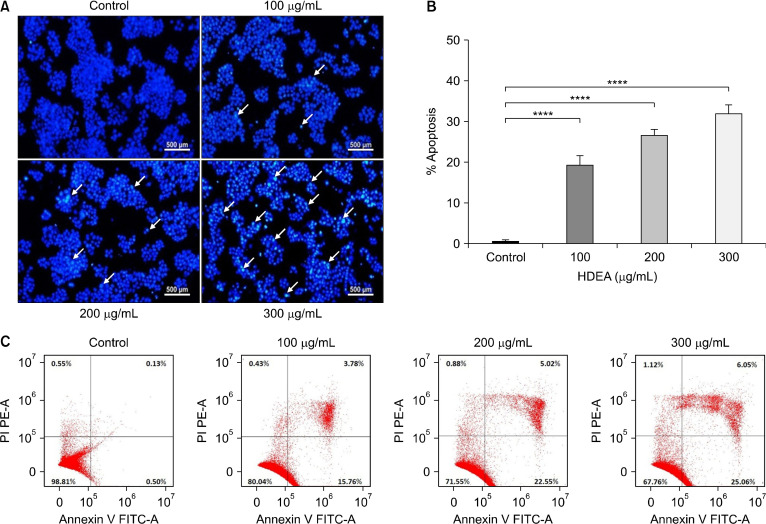
ฤทธิ์ของสารสกัดจากสาหร่ายลิ้นมังกรในการต้านเซลล์มะเร็งลำไส้ใหญ่ โดยการกระตุ้นการตายของเซลล์แบบ apoptosis และ autophagy
Highlight
การศึกษาการออกฤทธิ์ของสารสกัดจากสาหร่ายลิ้นมังกร Halymenia durvillei (HD) ในการต้านมะเร็งลำไส้ใหญ่ พบว่าสารสกัดจากสาหร่ายลิ้นมังกรในชั้น ethyl acetate สามารถฆ่าเซลล์มะเร็งลำไส้ใหญ่ (HT-29) ยับยั้งการแบ่งเซลล์กระตุ้นกระบวนการตายของเซลล์แบบ apoptosis และ autophagy รวมถึงการยับยั้งการแสดงออกของยีนในกลไก PI3K, AKT และ mTOR ได้ จึงสามารถสรุปได้ว่าสารสกัดจากสาหร่ายลิ้นมังกรในชั้น ethyl acetate สามารถต้านมะเร็งลำไส้ใหญ่โดยผ่านทางกลไก PI3K/AKT/mTOR ได้
ที่มาและความสำคัญ
มะเร็งลำไส้ใหญ่เป็นมะเร็งที่พบได้บ่อย ซึ่งถึงแม้จะมีแนวทางการรักษาในปัจจุบันทั้งโดยการผ่าตัดและการฉายรังสีที่ได้ผลเป็นอย่างดี แต่ก็มีผลข้างเคียงจากการรักษา รวมถึงการเกิดการดื้อยาขึ้น ดังนั้นจึงนำไปสู่การค้นหาแนวทางการรักษาใหม่ที่สามารถลดผลข้างเคียงที่เกิดขึ้น โดยศึกษาจากสารสกัดจากธรรมชาติ โดยเฉพาะจากสาหร่ายทะเลในการออกฤทธิ์ต้านเซลล์มะเร็ง เพื่อให้มีการรักษาที่มีประสิทธิภาพสูงขึ้น
Abstract
Colorectal cancer is one of the most death-dealing cancers. However, conventional cancer treatments still have side effects. Therefore, novel chemotherapeutic agents with less side effects are still in search. A marine red seaweed, Halymenia durvillei, is recently interested in its anticancer effects. This study investigated the anticancer effect of ethyl acetate extract of H. durvillei (HDEA) on HT-29 colorectal cancer cells in association with the phosphoinositide 3-kinase (PI3K)/protein kinase B (AKT)/mammalian target of rapamycin (mTOR) signaling pathway. HDEA-treated HT-29 and OUMS-36 cells were used for cell viability tests by 3-(4,5-dimethyl-2-thiazolyl)-2,5-diphenyltetrazolium bromide assay. The effects of HDEA on apoptosis and cell cycle were evaluated. The nuclear morphology and mitochondrial membrane potential (ΔΨm) were observed by Hoechst 33342 and JC-1 staining, respectively. The gene expression of PI3K, AKT, and mTOR genes was evaluated using a real-time semiquantitative reverse transcription-polymerase chain reaction. The corresponding protein expressions were assessed by western blot analysis. The result revealed that the cell viability of treated HT-29 cells diminished while that of OUMS-36 cells was non-significant. By the down-regulation of cyclin-dependent ki-nase 4 and cyclin D1, HDEA-treated HT-29 cells were arrested in the G0/G1 phase. By the up-regulation of cleaved poly(adenosine diphosphate-ribose) polymerase, caspase-9, caspase-8, caspase-3, and Bax, HDEA-treated HT-29 cells underwent apoptosis, but suppressed Bcl-2, disrupted nuclear morphology and ΔΨm. Furthermore, treated HT-29 cells underwent autophagy by up-regulation of light chain 3-II and beclin-1. Lastly, HDEA suppressed the expression of PI3K, AKT, and mTOR. Therefore, HDEA exerts anticancer effects against HT-29 cells, confirmed by apoptosis, autophagy, and cell cycle arrest induction via regulation of the PI3K/AKT/mTOR signaling pathway.
KEYWORDS: apoptosis, autophagy, colorectal cancer, H. durvillei, seaweed
Citation: Chantree P, Martviset P, Sornchuer P, Thongsepee N, Sangpairoj K, Meemon K, Niamnont N, Tamtin M, Sobhon P. Ethyl Acetate Extract of Halymenia durvillei Induced Apoptosis, Autophagy, and Cell Cycle Arrest in Colorectal Cancer Cells. Prev Nutr Food Sci. 2023 Mar 31;28(1):69-78. doi: 10.3746/pnf.2023.28.1.69.
RELATED SDGs:
SDG Goal หลัก ที่เกี่ยวข้อง
3. GOOD HEALTH AND WELL-BEING

ผู้ให้ข้อมูล: รองศาสตราจารย์ ดร.ไกร มีมล
ชื่ออาจารย์ที่ทำวิจัย: รองศาสตราจารย์ ดร.ไกร มีมล
ภาพถ่าย: รองศาสตราจารย์ ดร.ไกร มีมล
Tags: Apoptosis, Autophagy, colorectal cancer, H. durvillei, seaweed
